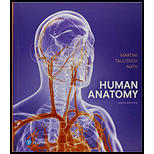
Concept explainers
Match each numbered item with the most closely related lettered item.
cardiac muscle cells.............................
To review:
Match the term cardiac muscle cells with the most closely related descriptions given below:
Vein to the left atrium
Covers outer surface of the heart
Supplies blood to heart muscle
Lines inner surface of fibrous pericardium
Slow heart rate
Functional syncytium
Muscular wall of the heart
Relaxation phase of the cardiac cycle
Vein to the right atrium
Contraction phase of the cardiac cycle
Introduction:
The heart’s wall is known as myocardium, which is made up of cardiac muscle cells. The cardiac muscle cells are made up of myofibrils, which consists of long chains of sarcomeres. These cells show striates similar to those shown in the skeletal muscle cells.
Explanation of Solution
A true syncytium possesses multiple nuclei, like the cells of the skeletal tissues. On the other hand, the cardiac muscles do not consist of multinucleated cells. Instead, they show functional syncytium as they are separated by the gap junctions and here when one cell gets contracted the contraction triggers the contraction of other cells and likewise the contraction carries by the whole myocardium. This property of the cardiac cells allows rapid contraction of the heart muscles without getting fatigued.
Therefore, it can be concluded that the cardiac muscle cells can be correctly matched with option (f) functional syncytium.
Want to see more full solutions like this?
Chapter 21 Solutions
Human Anatomy (9th Edition)
- (a) Name the type of blood vessel labelled (i) C. (ii) D. (b) In which direction does blood in vessel A travel? (c) Which of the four blood vessels contains the most oxygen? (d) What happens to the amount of oxygen in the blood as it passes through the body organs? (e) What is the chamber of the heart labelled X? ·arrow_forwardThe forearm and hand would continue to receive oxygenated blood if the complete blockage occured at which of the following sites? (A) a (B) b (C) c (D) darrow_forwardThe simple squamous epithelium covering the valves of the heart is called(a) epicardium. (b) endocardium. (c) myocardium. (d) endothelium.arrow_forward
- The sequence of contraction of the heart chambers is (a) random, (b) left chambers followed by right chambers, (c) both atria followed by both ventricles, (d) right atrium, right ventricle, left atrium, left ventricle.arrow_forwardDiscuss in details the unique structure of a cardiac muscle fiber.arrow_forwardThe amount of blood forced out of the heart depends on the, (a) degree of stretching at the end of ventricular diastole. (b) contractility of the ventricle.(c) amount of pressure required to eject blood. (d) a, b, and c are correct.arrow_forward
- Compared with the interstitial fluid that bathes active muscle cells, blood reaching these cells in arteries has a(A) lower osmotic pressure.(B) higher PO2.(C) lower pH.(D) higher PCO2.(E) greater bicarbonate concentration.arrow_forwardAn area of dead myocardial tissue is called.....arrow_forwardDescribe the structure of intercalated discs in cardiac musclecells, and briefly discuss their functions.arrow_forward
- Ms. Smith jogs every morning to keep a healthy head (brain), heart, hands, and whole body. Autoregulation increases blood flow to the active skeletal muscles throughout her everyday workout. How does this work?arrow_forwardPulse is a direct measure of(A) blood pressure.(B) stroke volume.(C) cardiac output.(D) heart rate.arrow_forwardAs blood vessels increase in diameter, the amount of smooth muscle decreases and the amount of connective tissue increases. Explain why. (Hint: Remember Laplace's law)arrow_forward
 Human Anatomy & Physiology (11th Edition)BiologyISBN:9780134580999Author:Elaine N. Marieb, Katja N. HoehnPublisher:PEARSON
Human Anatomy & Physiology (11th Edition)BiologyISBN:9780134580999Author:Elaine N. Marieb, Katja N. HoehnPublisher:PEARSON Biology 2eBiologyISBN:9781947172517Author:Matthew Douglas, Jung Choi, Mary Ann ClarkPublisher:OpenStax
Biology 2eBiologyISBN:9781947172517Author:Matthew Douglas, Jung Choi, Mary Ann ClarkPublisher:OpenStax Anatomy & PhysiologyBiologyISBN:9781259398629Author:McKinley, Michael P., O'loughlin, Valerie Dean, Bidle, Theresa StouterPublisher:Mcgraw Hill Education,
Anatomy & PhysiologyBiologyISBN:9781259398629Author:McKinley, Michael P., O'loughlin, Valerie Dean, Bidle, Theresa StouterPublisher:Mcgraw Hill Education, Molecular Biology of the Cell (Sixth Edition)BiologyISBN:9780815344322Author:Bruce Alberts, Alexander D. Johnson, Julian Lewis, David Morgan, Martin Raff, Keith Roberts, Peter WalterPublisher:W. W. Norton & Company
Molecular Biology of the Cell (Sixth Edition)BiologyISBN:9780815344322Author:Bruce Alberts, Alexander D. Johnson, Julian Lewis, David Morgan, Martin Raff, Keith Roberts, Peter WalterPublisher:W. W. Norton & Company Laboratory Manual For Human Anatomy & PhysiologyBiologyISBN:9781260159363Author:Martin, Terry R., Prentice-craver, CynthiaPublisher:McGraw-Hill Publishing Co.
Laboratory Manual For Human Anatomy & PhysiologyBiologyISBN:9781260159363Author:Martin, Terry R., Prentice-craver, CynthiaPublisher:McGraw-Hill Publishing Co. Inquiry Into Life (16th Edition)BiologyISBN:9781260231700Author:Sylvia S. Mader, Michael WindelspechtPublisher:McGraw Hill Education
Inquiry Into Life (16th Edition)BiologyISBN:9781260231700Author:Sylvia S. Mader, Michael WindelspechtPublisher:McGraw Hill Education





